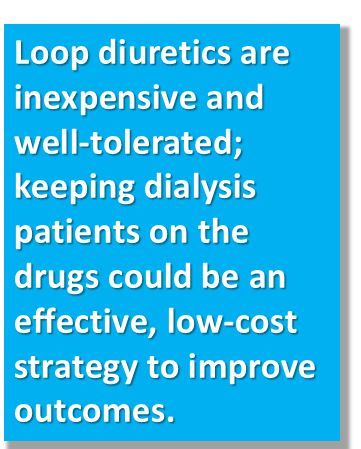Loop Diuretics During Dialysis Reduce Hospitalization, Hypotension, Weight Gain
Keeping a loop diuretic on board during dialysis could be an effective, low-cost option to help improve patient outcomes, according to a new study.

While diuretics are often stopped before dialysis is initiated, continuing them was linked to improved clinical outcomes in a recent analysis that included more than 11 000 patients.
Continuing loop diuretics was associated with lower rates of hospitalization, hypotension, and weight gain, according to the analysis of patients undergoing in-center hemodialysis at a large dialysis organization between 2013 and 2016.
These findings suggest that continuing diuretics in dialysis could be an effective and low-cost strategy to improve outcomes and individualize care, according to researcher Jennifer Flythe, MD, MPH of the UNC School of Medicine in Chapel Hill, and co-researchers.
“Diuretics are inexpensive and well-tolerated, and thus likely a reasonable intervention in dialysis patients who still make urine,” Dr. Flythe said in an interview.
Lower risk of all-cause hospitalization
The intervention could help dialysis-dependent patients by providing protection from the adverse effects of fluid overload, and may allow for more dietary freedom through enhanced potassium excretion, Dr. Flythe and co-investigators said in their report, published in the Clinical Journal of the American Society of Nephrology.
Their retrospective study was based on data for 11 297 patients who had an active supply of loop diuretic, mainly furosemide (83%), at the start of dialysis.
Risk of all-cause hospitalization was 7% lower in the patients who continued on the diuretic, Dr. Flythe and co-investigators reported.
Reducing inpatient care, the authors note, could be a valuable benefit, as hospitalization increases costs and risk of death among dialysis patients. The results did demonstrate a trend toward improved mortality, with an 8% risk reduction that did not reach statistical significance.
They also observed a 5% reduced risk of intradialytic hypotension, and significantly lower interdialytic weight gain (P = 0.03) in the patients continuing the diuretic versus those who discontinued.
Time to reconsider practice?
Based on those findings, clinicians “should reconsider” the practice of discontinuing loop diuretics for patients on incident dialysis, Dr. Flythe and colleagues said in their report.
While loop diuretics can lead to ototoxicity and electrolyte abnormalities, dialysis patients have frequent contact with health care providers, and so could be closely monitored for these and other side effects, investigators said.
“Based on experience elsewhere in the world, for example in Europe, these complications are uncommon except at very high doses,” Dr. Flythe said. “As with any intervention, the risk:benefit ratio must be considered on an individual patient-by-patient basis."
While diuretics are often prescribed in patients with chronic kidney disease who are not dialysis-dependent, the Dialysis Outcomes and Practice Patterns Study (DOPPS) from 2007 found that only 21% of dialysis patients continued on loop diuretics.
In the present study, 5,219 patients (46%) apparently continued taking the diuretic, as evidenced by a refilled prescription after dialysis had started.
Taken together, this study and the DOPPS study make it clear that most dialysis patients discontinue loop diuretics, Dr. Flythe and co-investigators said.
However, to confirm that continued diuretics would provide a benefit in those patients, prospective clinical trials need to be conducted, Dr. Flythe and colleagues said in their report.
References:
Sibbel S, Walker AG, Colson C, et al. Association of continuation of loop diuretics at hemodialysis initiation with clinical outcomes. Clin J Am Soc Nephrol. 2019;14:95-102.